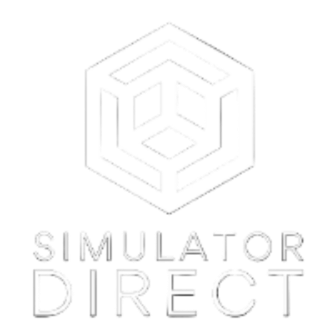
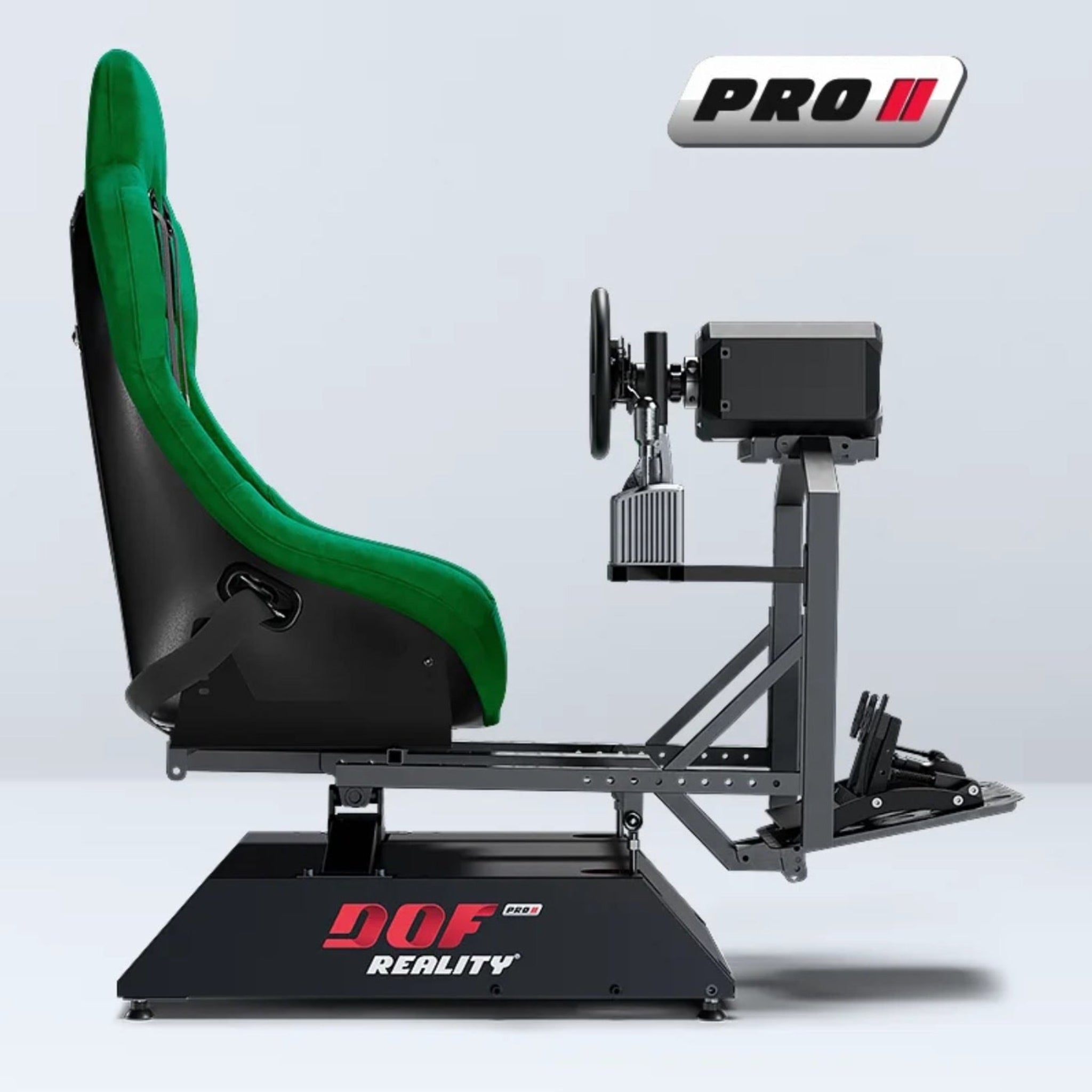
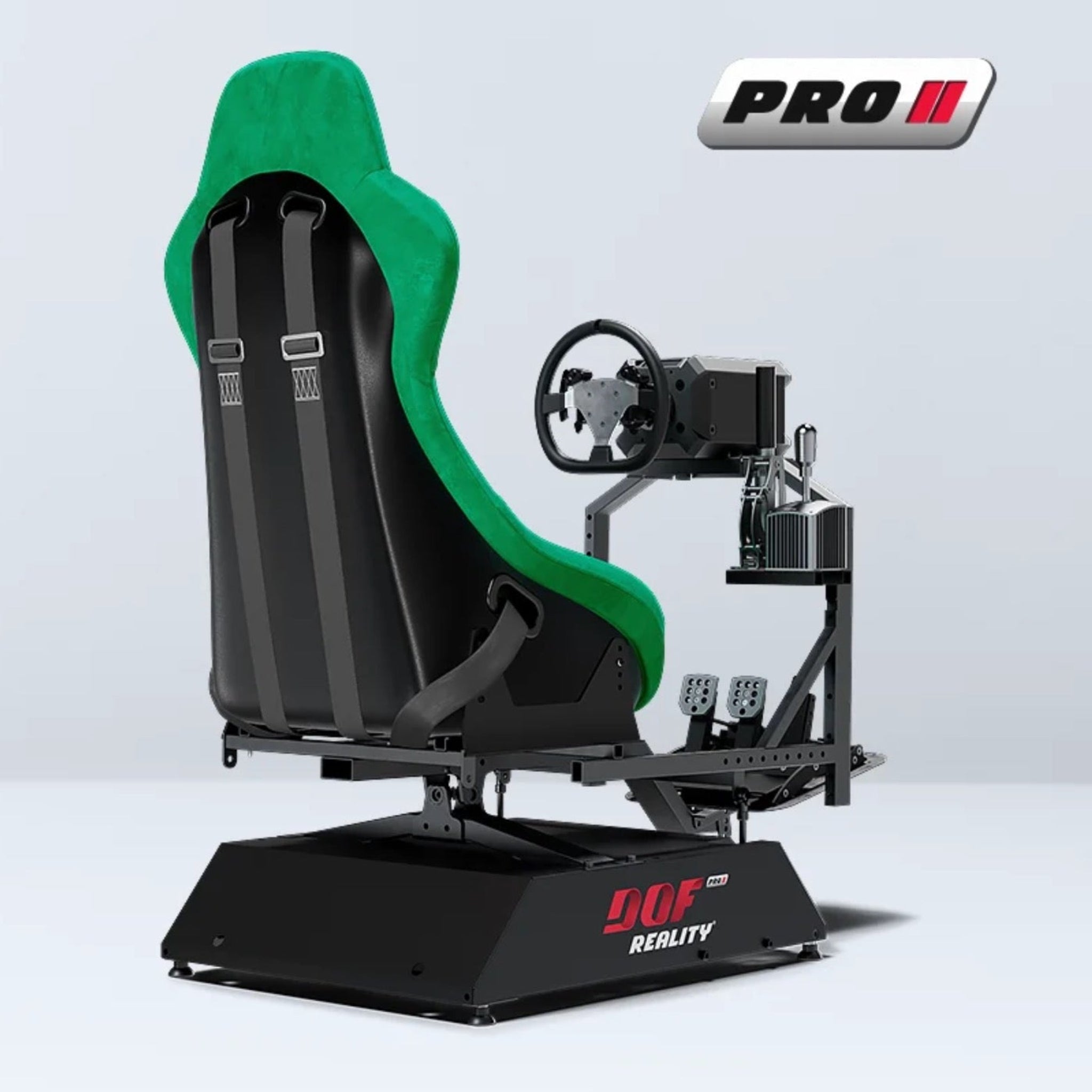
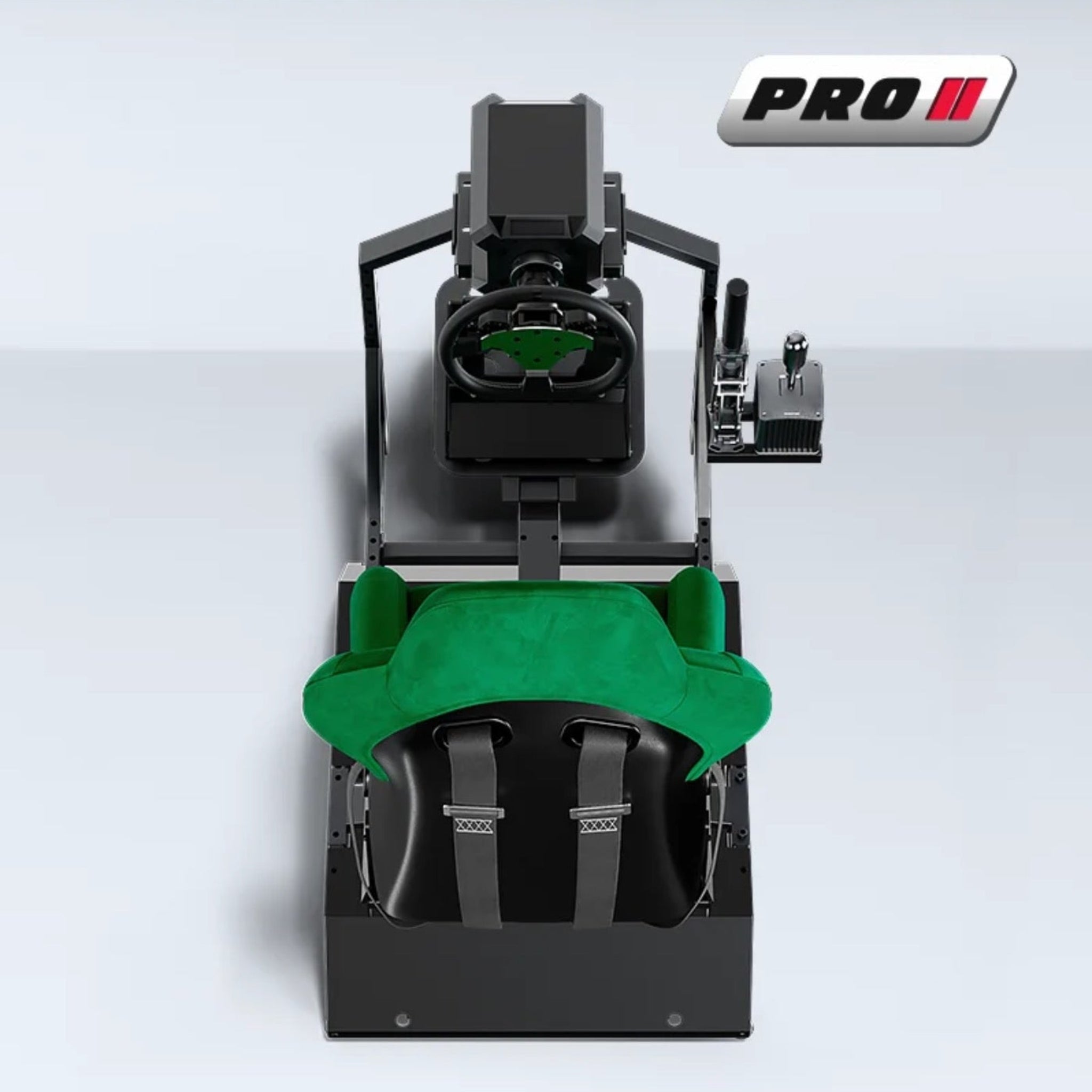
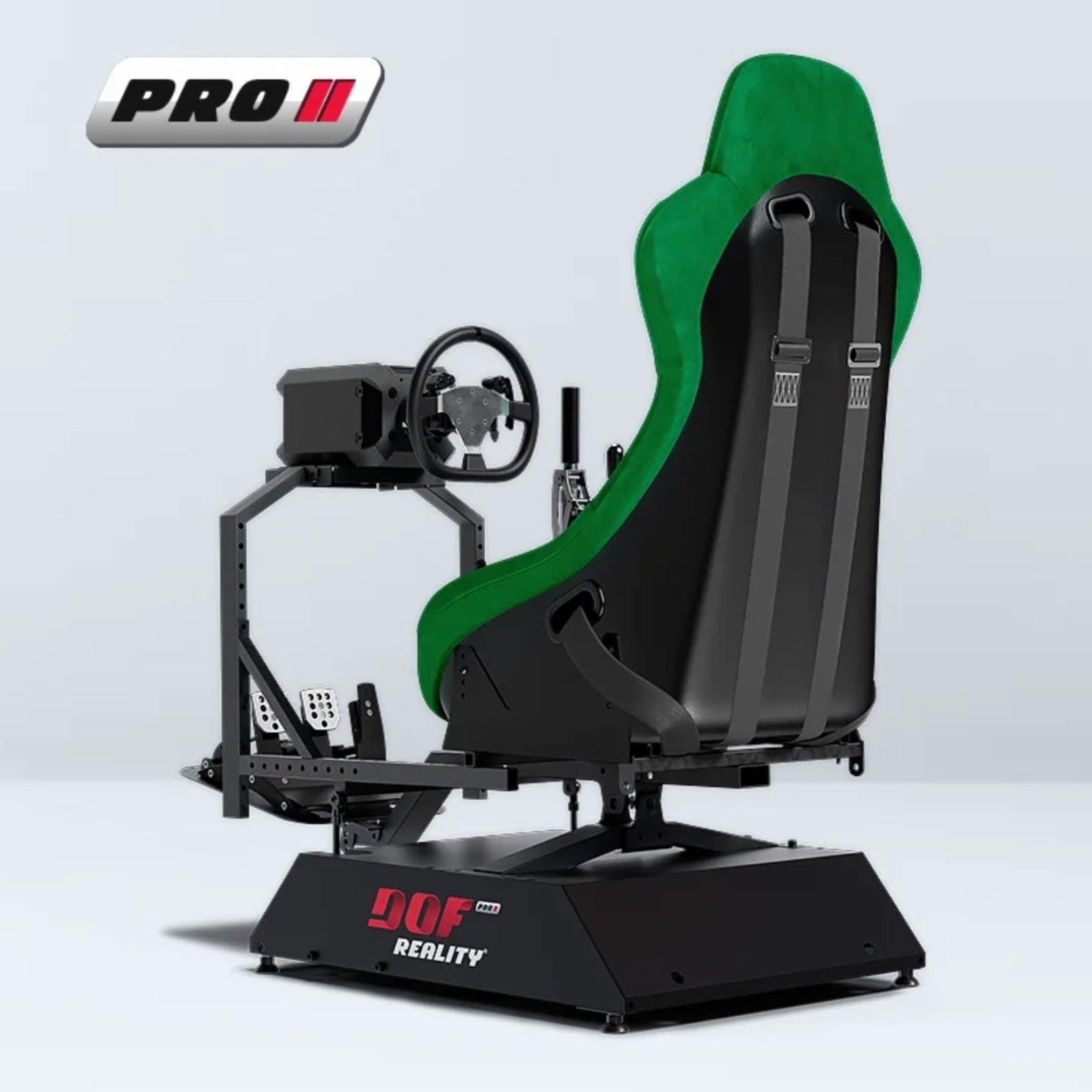
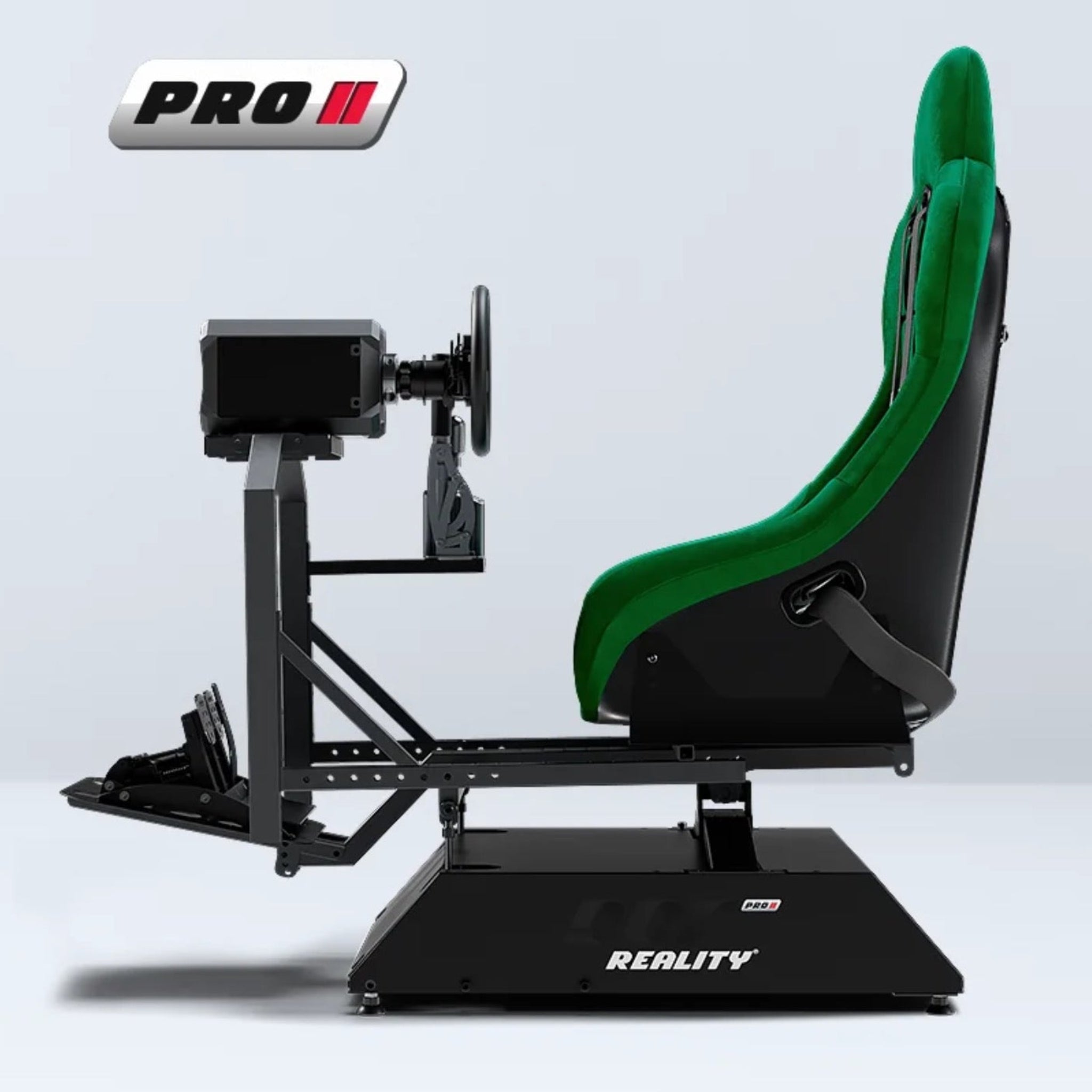


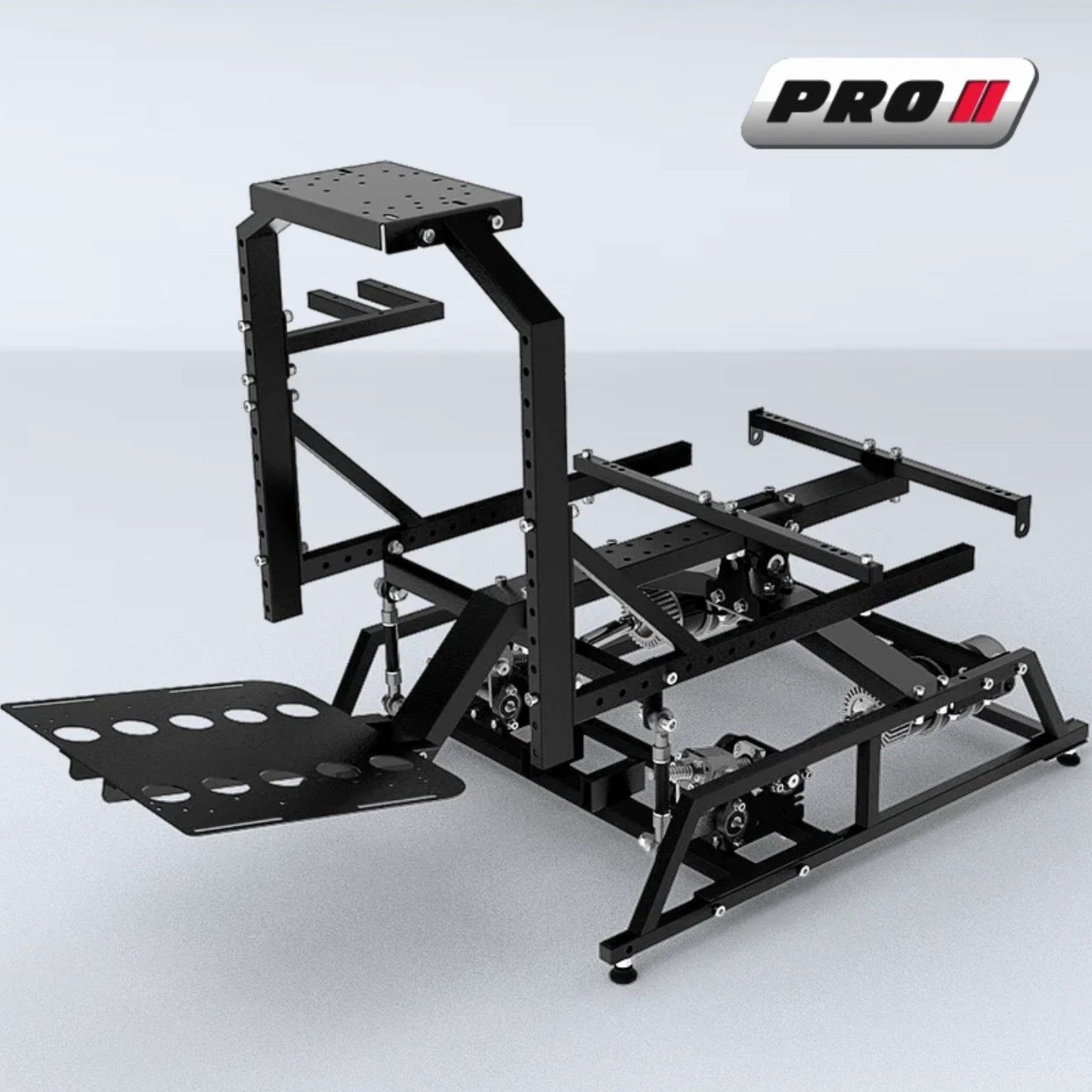

DOF Reality P2 Professional Universal Motion Simulator Platform
Choose options










Fast, Secure Shipping
Orders are processed promptly and shipped directly from trusted suppliers for safe, reliable delivery.
Lowest Price Guarantee
Found a better price? We’ll match it — Guaranteed.
Simulator Expertise
Talk to a Real Expert
(714) 202-9416
Mon–Sat 8AM–5PM PST
- Description
- Product Features
- What's Included
- Product Specifications
- Getting Started Guide
- Product Installation Guide
- Add Ons
- FAQ's
- Shipping/Returns & Warranty Policy
DOF Reality P2 2-Axis Professional Universal Motion Simulator Platform
Commercial-duty motion for serious racers, training centers, and high-end sim setups.
The DOF Reality P2 Professional is a 2-axis motion platform built for environments where simulators run hard and often—flight schools, VR arcades, training labs, and dedicated home cockpits. With pitch and roll movement and a full-cockpit motion design, the P2 replicates the key physical cues of real flight: rotation on climb and descent, banking through turns, turbulence, approach corrections and more.
Unlike DOF Reality’s enthusiast H-series, the P-series uses stronger, stiffer motors and commercial-grade drivetrains designed to run for extended sessions (around 10 hours per day, day after day) without overheating or losing performance.
If you need a platform that feels realistic and is built for heavy, repeated use, the P2 is your professional-grade starting point.
Product Features:
2-Axis Full-Motion Platform (Pitch + Roll)

|
Key Feature |
Description |
|---|---|
|
2-Axis Full-Platform Motion (Pitch & Roll) |
Delivers motion in two core axes — pitch (nose up/down, acceleration & braking) and roll (side-to-side body lean) — giving you convincing tilt feedback for racing, flight, heli and truck sims on a single platform. |
|
Professional P-Series Motors |
Uses stronger, more rigid P-Series motors and drivetrains compared to the H-Series, engineered for long, repeated daily use (around 10 hours/day) in commercial environments like sim centers and VR arcades. |
|
Universal Application |
Sold as a Universal platform, the P2 can be configured for racing, flight, helicopter, truck, off-road and mixed-use cockpits, letting you swap top-side controls (wheel, yoke, HOTAS, etc.) without changing the motion base. |
|
Full-Cockpit Movement |
Moves the entire rig—seat, wheel or yoke, pedals, shifter or HOTAS and attached accessories—so your hands, eyes and body all share the same motion, which feels more natural and immersive than a simple seat mover. |
|
Smooth, Responsive Motion |
The P2’s drive system is tuned for smooth low-speed motion (great for flight attitudes and gentle banking) while still offering snappy responses for race starts, braking zones, curbs and weight transfer. |
|
Compact, Rigid Frame |
Built on a compact steel chassis designed to fit in dedicated sim rooms, studios or commercial bays, while remaining rigid enough for stronger FFB wheels and premium pedal sets. |
|
PC & VR Ready |
Designed to work with PC motion software (e.g., SimRacingStudio, SimTools) for major racing and flight titles, and pairs very well with VR headsets when combined with motion compensation or rig-mounted tracking. |
|
Upgrade-Friendly Platform |
A solid foundation for future growth—ideal if you start with 2-DOF and later plan to move up to 3-axis or 6-axis within the DOF Reality ecosystem, depending on your long-term needs and budget. |
Software & Game Compatibility

Through motion middleware like SRS or SimTools, the P2 can be mapped to a wide range of titles, including for example:
-
Racing sims – Assetto Corsa / Competizione, iRacing, rFactor 2, F1 series, Dirt Rally, Project CARS and more
-
Flight sims – Microsoft Flight Simulator, X-Plane, DCS World, IL-2, Prepar3D (via telemetry plugins)
-
Helicopter & VTOL – heli-focused profiles leveraging the P2’s smooth low-speed roll and pitch
-
VR roller-coaster and experience titles – via telemetry or custom plugins where supported
Who the P2 Universal Is Perfect For
-
Commercial VR and sim arcades wanting a universal motion base that can switch between racing, flight and helicopter titles.
-
Training facilities and schools needing a robust, repeatable motion platform for attitude awareness and procedure practice.
-
High-end enthusiasts who want professional-grade motors and long-session durability.
-
Content creators and event companies looking to run motion rigs all day at conventions or demos.
What's Included:
|
Item |
Description |
|---|---|
|
DOF Reality P2 2-Axis Motion Base |
Professional 2-DOF (pitch & roll) motion platform with P-series motors and SFU/extra-smooth gearboxes pre-installed. |
|
Universal Steel Frame |
Rigid frame with mounting slots/rails for seat, wheel or yoke, pedals, shifter/HOTAS and accessories. |
|
Motor & Linkage Assembly |
Industrial motors, gearboxes and motion linkages factory-mounted to the platform. |
|
Electronic Control Unit |
Motion controller with USB interface and power input (100–240 V AC, 50/60 Hz). |
|
Mounting Hardware |
Bolts, brackets and basic fasteners required for assembling the platform and attaching controls. |
|
Setup & Software Instructions |
Documentation and guidance for connecting the rig to motion software (e.g., SimRacingStudio / SimTools) and supported sims. |
Note: Seat, controls (wheel/yoke, pedals, HOTAS), displays, PC and VR headset are sold separately
Product Specifications:
|
Specification |
Detail (Approx.) |
|---|---|
|
Motion Type |
2-axis full-platform motion (pitch & roll) |
|
Degrees of Freedom |
2 DOF – Pitch (forward/back tilt), Roll (side-to-side lean) |
|
Intended Use |
Professional / commercial (P-series) – designed for long daily runtimes |
|
Drive System |
P-series motors with extra-smooth gearboxes and SFU drive |
|
Motion Range |
Up to ~20° of movement per axis (configuration dependent) |
|
Maximum Speed |
Up to ~75 cm/s (~105°/sec) under typical load |
|
Supported Load |
Up to ~200 kg (combined user + cockpit), depending on setup |
|
Platform Weight |
Approx. 40–50 kg (varies by options) |
|
Input Voltage |
100–240 V AC, 50/60 Hz (auto-switching) |
|
Peak Power Draw |
Roughly 500–750 W under heavy motion |
|
Compatibility |
Works with SimRacingStudio, SimTools and similar telemetry-based motion software |
|
Typical Sims |
Major PC racing & flight sims (e.g., Assetto Corsa, iRacing, MSFS, X-Plane, DCS) via supported plugins |
|
Motion Coverage |
Full-cockpit motion: seat, controls and small monitor mounts can all move together |
(Exact numerical specs can vary slightly based on configuration and year of manufacture; always check the current DOF Reality datasheet if you need precise engineering numbers.)
Getting Started Guide:
1. Unpack and verify components
Carefully open the crates/boxes, remove all padding, and lay out the motion base, frame pieces, control box, and hardware; check them against the packing list so you know you’re not missing any brackets, bolts, or cables before you start building.
2. Choose and prepare the installation area
Pick a flat, rigid surface (concrete, plywood platform, or heavy-duty floor) with enough room for the full cockpit plus motion travel on all sides, and confirm you have nearby power outlets and safe cable paths away from moving parts.
3. Assemble the steel frame
Follow DOF Reality’s diagram to bolt together the main base frame, crossmembers, and any support plates, tightening bolts by hand at first so you can make minor adjustments before doing a final torque pass with tools.
4. Position and secure the motion base
Place the P2 motion base on the assembled frame in the orientation shown in the manual, align mounting holes, and tighten the base mounting bolts securely so the actuators and linkages can’t shift under load.
5. Mount your seat and primary controls
Install your racing or flight seat on the seat rails/plates, then mount your wheelbase/yoke, pedals, shifter or HOTAS using the slotted brackets; adjust fore/aft and vertical positions until your seating ergonomics feel natural before fully tightening everything.
6. Add accessories and test clearances
If you’re using side consoles, button boxes, small monitor arms, or keyboard trays, mount them now and slowly move the platform by hand through its full range to make sure nothing hits the frame, floor, or walls.
7. Connect the control electronics
Place the control box where it has airflow, connect the motor/actuator cables to their labeled ports, plug the USB cable into your PC, and then connect the power cable to a grounded outlet or quality surge protector (but don’t turn it on yet).
8. Install motion software on your PC
Download and install the recommended software (commonly SimRacingStudio or SimTools), ensure your USB drivers are correctly recognized, and select the DOF Reality P2 profile/device inside the software so it can talk to the control box.
9. Power on and run initial motion tests
Turn on the control box, open your motion software, and run its built-in test or calibration routine; watch the platform carefully as it moves through pitch and roll to confirm smooth, noise-free travel with no cables stretching or snagging.
10. Configure game profiles and fine-tune motion
Enable telemetry/motion output in your main sim titles, apply a starting profile for each (e.g., racing vs flight), then adjust intensity, smoothing, and axis limits gradually until the motion feels strong enough to be immersive but comfortable for long sessions.
Setup & Installation Recommendations:
Space & Safety
-
Leave at least 12–18 inches of clearance around the platform so it can tilt without striking furniture, walls, or people.
-
Keep the rear and sides free of rigid obstacles—if something must be nearby, use padding or soft materials.
-
Position the rig so the user can enter/exit easily without stepping over moving parts or cables.
-
If the platform is on a raised deck, use non-slip surfaces and consider bolting the frame down for extra stability.
Mounting & Hardware
-
Use the supplied washers and lock nuts, and apply a medium threadlocker (e.g., blue Loctite) on high-stress bolts such as seat mounts and frame joints.
-
Make sure your chosen seat and controls are within the recommended weight range, especially if you add heavy aftermarket brackets or monitor mounts.
-
Re-check all bolts after the first few hours of use, then periodically (e.g., monthly in commercial use) to catch any loosening from vibration.
-
When experimenting with new accessories, do a slow manual motion check (moving axes in software at low speed) before running full-force profiles.
Cabling & Power
-
Route motor, USB, and accessory cables along the frame rails, securing them with zip ties or Velcro straps so they have slack but never cross a pivot or actuator path.
-
Avoid running signal and power cables tightly bundled together over long distances to reduce electrical noise; cross them at right angles where possible.
-
Use a quality surge protector or UPS rated for at least 1,000–1,500 W to protect the control electronics from spikes.
-
Keep ventilation grills on the control box unobstructed; don’t place it directly on thick carpet or inside a sealed cabinet.
Software & Tuning
-
Start with conservative motion settings (lower gain and speed) while you learn how the platform behaves, then gradually increase intensity.
-
Maintain different profiles for racing, flight, and helicopter—flight typically benefits from smoother, lower amplitude motion, while racing can handle sharper, more aggressive cues.
-
For VR use, enable motion compensation or attach a tracking puck to the moving rig when your software supports it, minimizing VR drift and motion sickness.
-
Keep firmware and motion software up to date, as vendors often add new titles, bug fixes, and improved motion filters.
Maintenance & Longevity
-
Wipe dust from actuators, linkages, and the control box periodically to promote cooling and reduce wear.
-
Listen for new or unusual noises—grinding, clunking, or excessive squeaks can be early signs that a bolt has loosened or something is misaligned.
-
In commercial environments, create a simple maintenance checklist (visual inspection, bolt check, cable check) to run weekly.
-
If you plan to move the rig, unplug power and USB first, lift from the frame (not from motors or linkages), and re-run a brief calibration test after repositioning.
Videos:
Add On Options:
2 DOF Transportation Wheels:

This option is an portability addition. It provides two heavy duty front side wheels to the platform. One person can lift the the whole assembled platform from the back and the front wheels will touch the floor allowing quick movement, and for loading and unloading the whole platform. It great for frequent relocations in the house or during events. This kit fits H2 and P2 platforms.
Metal Cyber Cover:

Enclosure for protection of lower moving parts of your platform. Metal CyberCover is built with an outer shell designed for ultimate durability and passenger protection. It offers an innovative approach to materials and shapes. No dust, no risk. Cover your sim with a practical and futuristic design.
- Protect pets and children
- Hides the technical guts of your platform
- Provides a seamless, sleek design
- Protects the mechanics from dust and spills
- Structurally designed to be lightweight and durable
- Precision laser-cut, powder-coated steel
This cover fits H2, H3, P2 and P3 platforms.
Keyboard Holder:

We offer an adjustable keyboard holder that can be comfortably attached to motion parts of the rig and hold the keyboard. The most popular sim keyboard is Logitech K400 Plus Wireless Keyboard with Touch Pad .
Pedals Quick Release:

HoneyComb A+B Adapter:

If you have HoneyComb Alpha Bravo yoke and throttle this adapter will make them fit to our standard wheel plate.
Monitor Mount:

Now we offer VESA standard (100 mm × 100 mm) mount for one monitor up to 33lbs (15kg). Make sure you have the SFU gearboxes and the latest(wide) wheel support vertical bars before ordering it.
MagicBox for PS5/XBOX:

With this Console Link (MagicBox) , you don’t need a proxy Windows PC anymore. Console Link host SimRacingStudio and get motion information directly from the console. Now you can get motions from the console games and control SRS with your phone or tablet. You need it only if you plan to play only console games and only without a PC. This works only for motion, not other controllers such as wheels pedals etc. Just plug DOF Reality motion platform to the Console Link and enjoy console sims.
eBreak Stop Button:

E Break emergency button can be placed on the platform within a close reach to stop any platform motions immediately. It is compatible with any platform model.
HOTAS Mounts Kit:

Flight controls mounts kit for HOTAS. It includes throttle and flight joystick mounts. Joystick can be mounted in the center or on the side. This kit fits all our platform except M series.
Soft Protection Cover:

To protect you we also provide flexible moving parts protection cover. This cover fits H2, H3, P2 and P3 platforms.
Cables Extension Set for 2-3 DOF:

This is set of cables from the control box to the motors. Standard cables are 1.2m (4′) long and enough for any common installation. for 2-3 DOF platforms the best place for the control box is under the pedals plate. For 6 DOFs under the seat. This will minimize cables management. The Cables extension set is needed only for the customers who, for some reason, wish to place the control box further away from the platform.
Buttkicker Mount:

Mount for the Buttkicker. “ButtKicker” is actually a brand of tactile transducer, not a seat or a separate motion platform.
It’s a vibration unit that bolts to your rig (often under the seat or to the frame) and shakes in response to audio or telemetry, so you feel engine rumble, road texture, gear shifts, explosions, etc.
ButtKicker adds fine-grain vibration:
-
Engine RPM & idle rumble
-
road kerbs, bumps, gravel
-
gear changes, wheel slip
-
runway bumps and touchdown thumps in flight sims
This is a bracket designed to place the ButtKicker in the ideal spot on the frame (usually on a crossbar or under the seat) so vibrations transfer efficiently.
Frequently Asked Questions:
Q: What’s the main difference between the H2 and the P2?
The H2 and P2 both provide two motion axes—pitch and roll—but the P2 is part of DOF Reality’s Professional (P-Series) line, which uses stronger, more rigid motors and smoother gearboxes designed to run for long sessions (around 10 hours per day) in commercial environments. In short, H2 is aimed at home enthusiasts, while P2 is built for heavier duty, higher load, and long-term commercial use.
Q: Can I use it for both flight and racing sims?
Yes. The P2 is a Universal platform, meaning it works great for wheel-based racing rigs, yoke or joystick flight decks, helicopter controls, truck sims, and even custom training simulators. You can mount different cockpits on the same base, making it ideal if you want one motion platform that can do a bit of everything.
Q: How noisy is it?
The P2 is designed to be surprisingly quiet for a motion platform, typically in the mid-40s to low-50s dB range under normal load—similar to a desktop PC or a quiet dishwasher. You’ll hear motor and gearbox movement when the rig is working hard, but it’s usually very manageable for home and studio environments.
Q: Is the setup complicated?
Most users find the setup very manageable. You’ll assemble the frame, bolt on the motion base, mount your seat and controls, connect the control box, and install motion software on your PC. If you’re comfortable building flat-pack furniture or a regular sim rig, you can set up the P2; plan for a few hours for careful assembly and tuning on your first build.
Q: Can I upgrade later?
Yes. DOF Reality platforms are modular, and many customers later move up to 3-axis or 6-axis systems (such as P3 or P6/H6) or add traction-loss modules. Exact upgrade paths and kits can vary by model year, so if you plan to expand in the future, we recommend contacting us before purchase so we can confirm the best upgrade route for your setup.
Q: What is the maintenance schedule?
The P2 is largely maintenance-light. For most users, it’s enough to:
-
Inspect and tighten major bolts every few months,
-
Keep dust off the actuators, linkages, and control box, and
-
Apply a small amount of lubricant to moving joints or sliding points every 6–12 months in heavy use.
Commercial users running the rig daily should build a simple weekly visual check into their routine.
Q: What’s included in the box, and what do I need to supply?
You get the P2 motion base, universal steel frame, motors, control electronics, and mounting hardware. You will need to provide your own seat, wheelbase/yoke, pedals, shifter/HOTAS, PC, monitor/VR headset, and simulator software. This lets you choose the exact controls and style of cockpit you prefer.
Q: How much space do I need for the P2?
The platform itself has a compact footprint (roughly the size of a typical sim rig), but you should allow extra room around it for motion travel and safe entry/exit. As a rule of thumb, plan for at least a 6 ft x 6 ft area for the rig and user, plus enough ceiling height for your seat and your tallest user.
Q: What is the weight capacity?
The P2 Professional is built for heavier commercial use and is designed to handle a combined load of roughly up to 200 kg (about 440 lb) including the user, seat, and attached cockpit components. Very heavy custom builds should be discussed with us in advance so we can confirm suitability.
Q: Will it work with Playstation and Xbox?
Yes.
Consoles operate within a closed, controlled, and proprietary platform. Currently, only a select few games, such as Grand Turismo 7, Sport, PCARs, PCARs2, AC, F1, Forza Motorsport 7, and Forza Horizon 4 and 5, send motion data from consoles using UDP over the network (as demonstrated in this video).
For these games, we offer a MagicBox solution priced at $200. To enable motion in all other games, we are developing MagicWheel and MagicPedals, which will be available in two months.
For a list of supported PC and console games, including compatibility with the latest consoles, please refer to our games list.
Q: What seat should I use with your platform?
Your seat setup is all about personal comfort and driving style. The P2 Motion Platform supports almost any bottom-mount car or gaming seat, giving you the freedom to choose what feels best.
We recommend using a bucket-style racing seat for added stability during high-intensity motion. A 4- or 6-point harness can be added for extra security, though it’s optional. For best performance, opt for a lightweight seat, as it allows the motion platform to react faster and more precisely.
You can purchase a suitable seat from Amazon, JEGS, or eBay, or even check local listings and racing communities for single bucket seats. When shopping, look for non-certified racing seats — they deliver the same experience at a much lower price compared to FIA-certified options.
For convenience and easy adjustment, we recommend using a standard bottom-mount car seat with sliders or rails, similar to what’s found in real cars. If you choose a bucket seat, you may need side-to-bottom bracket adapters and slider rails for installation.
Seat Mount Dimensions:
-
Depth: 280 mm (front to back)
-
Width options: 345 mm (13.37”), 375 mm (14.49”), or 405 mm (15.94”)
Q: Does it come assembled?
To ensure safe and convenient delivery, each unit is shipped in two separate boxes. Some assembly is required upon arrival — this process allows you to customize your setup to fit your exact preferences and ensures you’re fully familiar with your new system.
Assembly is straightforward and intuitive, making setup an enjoyable and rewarding part of the experience.
Q: How motion cancellation / compensation works with your platforms?
The DOF Reality motion simulator is fully compatible with all major VR headsets. However, combining motion simulation with VR requires a few setup considerations to ensure smooth and immersive gameplay.
When your motion platform moves, your head—and therefore your VR headset—moves too. This can slightly shift the in-game view since the headset’s sensors interpret real-world motion. In most cases, this effect is minimal and won’t affect gameplay. You can see a clear example of this in action here:
If you notice excessive camera movement or “swimming” effects in your VR image, try reducing the platform’s motion intensity in your software settings. This simple adjustment often delivers a much smoother experience.
Software Solutions for Motion Compensation
If reducing motion doesn’t help enough, you can use motion compensation software to correct the visual offset automatically.
We recommend OpenVR Motion Compensation — the most up-to-date and community-supported software for this purpose. It tracks the platform’s motion using a small tracker and removes that motion from your VR headset’s perspective, creating a stable visual experience.
This software works with both base-station (outside-in) and camera-based (inside-out) tracking systems.
Supported VR Systems:
-
Outside-In Tracking (Base Stations): Valve Index, HTC Vive Cosmos, Pimax 5K/8K*, and the original Oculus Rift (CV1)
-
Inside-Out Tracking (Headset Cameras): HP Reverb/G2, Oculus Quest/Quest 2/Rift S**, Samsung Odyssey+, and Windows Mixed Reality headsets
Mounting and Tracking Setup
For base-station VR systems, mount a Valve Index Controller, HTC Vive Controller, or Vive Tracker directly to your motion platform. The tracker must be visible to all base stations—most users attach it near the headrest or top of the chair.
For inside-out tracking systems, mount an Oculus Touch Controller or WMR Controller on the front of the platform, ensuring it remains in clear view of the headset’s cameras.
In all cases, make sure the tracker is:
-
Securely mounted to the platform.
-
Isolated from vibration using additional weight or vibration-dampening materials like Sorbothane or soft rubber.
Additional Software Options
An older alternative is OpenVR Input Emulator, which still has limited community support despite being discontinued.
Download OpenVR Input Emulator
Platform-Specific Resources:
-
Pimax PiTool Software – enable “Motion Cancellation” under settings by selecting a Valve Index Controller as the motion sensor. (Note: functionality may vary.)
Important Note for Oculus Devices:
Because Oculus devices rely on Valve’s SteamVR driver, some users may notice:
-
Occasional black borders during large platform motions.
-
Slight inaccuracies in rotational compensation.
Hardware (Non-Software) Motion Compensation Methods
If you prefer a hardware-based fix, there are a few effective workarounds:
-
For inside-out tracking headsets: Cover one of the headset’s tracking cameras with tape to minimize tracking movement. See video tutorial
-
For Oculus Rift users: Use the included DOF Oculus mount to attach the Rift sensor directly to the platform and cover the headset cameras. This prevents the headset from visually jumping but disables full rotation tracking. To compensate, reduce yaw movement in your DOF software.
-
For original Oculus Rift (CV1): You can mount the sensor to the front of your DOF Reality platform using the provided bracket (mounts to the two rear holes on the wheel deck plate). Due to recent Oculus software updates, results may vary.
Additional VR Motion Compensation Resources
Shipping/Returns & Warranty Policy:
1. General Terms of Sale
All purchases made through Simulator Direct for DOF Reality products are governed by DOF Reality’s official Terms of Trade. Each product is sold new and compliant with all relevant international manufacturing and consumer laws.
Changes or special arrangements must be confirmed in writing prior to purchase.
2. Pricing and Payments
-
All prices are shown in USD and exclude local VAT, import duties, customs fees, or brokerage costs.
-
Customers are responsible for paying all applicable local taxes and import charges upon delivery.
-
Payment for custom-built or professional systems requires an upfront deposit before production begins.
-
Orders not paid within 5 business days will be placed on hold and cancelled after an additional 2 days if payment is not received.
-
Only one discount or promotion code may be applied per order. Discounts cannot be combined or applied retroactively.
-
Currency conversions displayed in local values are estimates only. Final pricing is determined by your bank’s exchange rate at the time of transaction.
3. Shipping Policy
Shipping Methods
-
All platforms and accessories are shipped in securely packed boxes via international freight.
-
Each system is assembled, tested, and calibrated before shipping, then disassembled for safe transport.
-
Customers will receive detailed assembly instructions and all tools required for setup.
Delivery Terms
-
Orders ship under DAP Incoterms (Delivered at Place).
This means you are responsible for import customs clearance and any local duties or taxes.
-
Shipping times vary by location, typically 5–7 business days after production is complete.
-
Pre-orders will have undefined shipping dates until production begins; estimated times are provided once in queue.
-
Delivery times may vary based on freight carrier schedules, customs processing, and regional conditions.
Shipping Cost Adjustments
-
Shipping rates listed on the website are estimates and may fluctuate based on destination or carrier rate changes.
-
If additional freight charges apply, customers will be notified prior to shipment for approval or refund.
Inspection Upon Delivery
Customers must inspect all packages immediately upon delivery.
Any missing or damaged items must be reported in writing within 48 hours. Failure to do so may void any replacement claim.
4. Returns and Refunds
Eligibility
-
Refunds are only granted if a product is defective and cannot be restored to working condition through joint support between DOF Reality and the customer.
-
Refunds will not be issued for “change of mind” or buyer’s remorse.
-
Shipping and return shipping costs are the responsibility of the customer.
-
Products must be properly packaged for return to prevent damage in transit.
-
Refunds, if approved, will be processed within 20 business days after the returned product is received and inspected.
Pre-Order and Custom Orders
-
All pre-order deposits are non-refundable.
-
Custom-built units cannot be cancelled or refunded once production has begun.
5. Warranty Policy
Coverage Period
All DOF Reality systems come with a 12-month limited warranty covering defects in materials or workmanship from the date of delivery.
Replacement or repaired components receive a 6-month warranty from their installation date.
Consumer Models (M & H Series)
-
Warranty applies to private, non-commercial use only.
-
Commercial use voids the warranty coverage.
-
Coverage excludes wear items such as motors, wheels, dampers, or mechanical joints subject to normal wear and tear.
Professional Models
-
Professional and commercial-grade systems also include a 12-month limited warranty with similar exclusions.
-
On-site service may be offered at DOF Reality’s discretion for professional setups.
Warranty Limitations
Warranty does not cover:
-
Normal wear and tear of moving components
-
Improper storage, installation, or use against the manufacturer’s recommendations
-
Unauthorized repairs or modifications
-
Over-tightening dampers or overheating motors above 70°C
-
Software-related issues or third-party system conflicts
Slight play in gearboxes (up to 10% of motion range) is normal and not considered a defect.
Claim Procedure
-
Report any issue in writing immediately upon discovery.
-
Provide photos, video, or diagnostic details as requested.
-
Simulator Direct/DOF Reality will evaluate the claim within a reasonable timeframe.
-
If approved, defective parts will be repaired, replaced, or shipped to you for replacement.
-
Customers are responsible for the cost and risk of returning defective parts.
If Simulator Direct/DOF Reality fails to resolve a covered issue within a reasonable time, the customer may request a cancellation and refund for that item.
6. Extended Warranty & Service Plans (Professional Models Only)
Optional extended warranty and software/hardware support packages are available upon request.
These plans are tailored to each installation and priced based on system specifications.
Contact support@simulatordirect.com for details.
7. Software License Terms
Each platform includes a Sim Racing Studio Standard License, sufficient for full motion operation.
Premium features are available through an optional paid Sim Racing Studio Premium subscription, purchased directly from Sim Racing Studio.
DOF Reality is not responsible for changes or telemetry issues in third-party software or games.
8. Liability Disclaimer
DOF Reality products are designed for private entertainment purposes only.
The company is not liable for:
-
Personal injury, loss of income, or indirect damages
-
Misuse, modification, or unintended operation of the product
-
Software or hardware malfunctions caused by third-party equipment
Maximum liability shall not exceed 50% of the total amount invoiced to the customer in the previous year, or $25 USD, whichever is lower.
9. Governing Law
All transactions are governed by the laws of Wyoming, USA.
Any disputes shall be resolved in accordance with Wyoming state law.
10. Contact Information
For warranty claims, returns, or technical support, please contact:
Simulator Direct
Email: support@simulatordirect.com

Newsletter
Exclusive Updates. Delivered Before Anyone Else.
